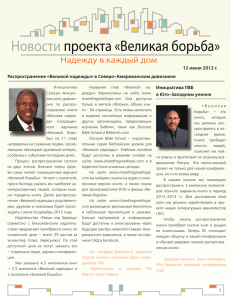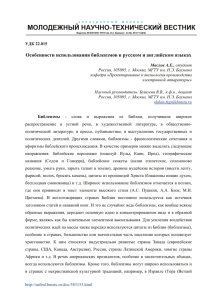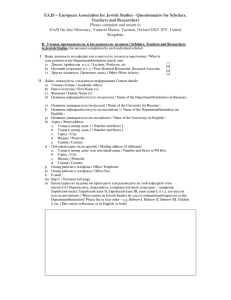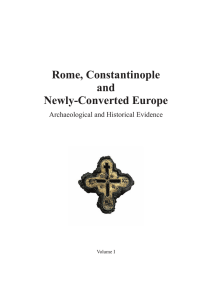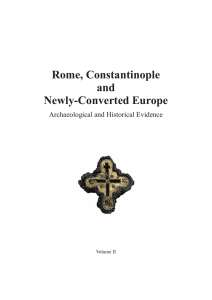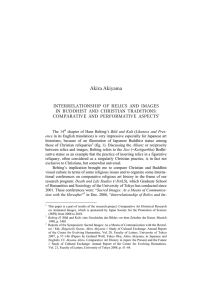
JAE_Summer2005_swcg 6/15/05 3:42 PM Page 6 Why Have Adventist Education? BY GEORGE R. KNIGHT n spite of its outstanding contributions to the church and the larger world, Adventist education is under fire. But the sad fact is that in the early 21st century, the attack all too often is coming from inside the denomination. Some pastors, for example, have argued that Adventist education “is stealing money from evangelism.” A concerned church member recently wrote that “the pastor of my church has decided that Christian education is irrelevant and not soul winning and therefore our local [Adventist] school should be closed so as not to waste any more of the money that he could be putting into his evangelism to win souls. He has previously sent out e-mails stating that it is his intention to see the school closed. Last school year, the school presented a church service at each of the constituent churches, except ours, because the pastor felt it was irrelevant to the members and a waste of time, and told them they were not welcome. He has even preached a sermon on the evils of not bearing fruit, which is a great sermon topic, except when his whole point was that our academy does not bear any visible fruits and therefore should be closed.” I them, as far as we can tell, was converted or even understood the central message of His teaching. Far from self-denial and servanthood, they were all arguing about who was the greatest, even as He ap- proached His sacrificial death. And, of course, one betrayed Him and another swore that he didn’t even know Jesus. What a wasted life! From a human perspective, Jesus could certainly have Taking the Long View As I read that letter, I wondered how that pastor would have evaluated the teaching/evangelistic ministry of Jesus. After all, He intensely taught a core of 12 disciples/students for three years, yet when He went to the cross, not one of 6 JOURNAL OF ADVENTIST EDUCATION • SUMMER 2005 JAE_Summer2005_swcg 6/15/05 3:42 PM Page 7 spent His time in a more profitable way. But He had His eye on the long run rather than the short term. After Pentecost, the majority of those disciples would be transformed into powerhouses for the gospel. So it is with Christian schooling. Results are generally not immediate. Ellen White caught that vision when she wrote of the resurrection morning: “All the perplexities of life’s experience will then be made plain. Where to us have appeared only confusion and disappointment, broken purposes and thwarted plans, will be seen a grand, overruling, victorious purpose, a divine harmony. There all who have wrought with unselfish spirit will behold the fruit of their labors. . . . How little of the results of the world’s noblest work is in this life manifest to the doer! . . . Parents and teachers lie down in their last sleep, their lifework seeming to have been wrought in vain; they know not that their faithfulness has unsealed springs of blessing that can never cease to flow; only by faith they see the children they have trained become a benediction and an inspiration to their fellow men, and the influence repeat itself a thousandfold. Many a worker sends out into the world messages of strength and hope and courage, words that carry blessing to hearts in every land; but of the results he, toiling in loneliness and obscurity, knows little. So gifts are bestowed, burdens are borne, labor is done. Men sow the seed from which, above their graves, others reap blessed harvests.They plant trees, that others may eat the fruit.They are content here to know that they have set in motion agencies for good. In the hereafter the action and reaction of all these will be seen.”1 Myopic vision just won’t do in evaluating the true value of Christian education. Short-term evaluations of longterm projects are nearly always distorted and inadequate. one college in the land where the Bible shall have its proper place in the education of the youth.”2 It does no injustice to that quotation to expand the idea to an entire system of Christian schools. But, and this is a crucial point, the Bible in an Adventist school is never studied as an end in itself. Rather, the Scriptures provide the framework for everything that takes place on campus, whether it be academics, extracurricular activities, chapels and Sabbath services, or work-study programs. 2. Chief among the “everything else” for which the Bible is instrumental in Adventist schools is introducing young people to Jesus Christ as Lord and Savior. At its core, Adventist education is evangelistic and redemptive. As the book Education puts it, “In the highest sense the work of education and the work of redemption are one. . . . To aid the student in comprehending these principles, and in entering into that relation with Christ which will make them a controlling power in the life, should be the teacher’s first effort and his constant aim. The teacher who accepts this aim is in truth a co-worker with Christ, a laborer together with God.”3 This redemptive role of education means that teaching is just as surely a form of ministry as that which takes place from behind a pulpit.4 Martin Luther glimpsed that idea. “If I had to give up preaching and my other duties,” he wrote, “there is no office I would rather have than that of school-teacher. For I know that next to the [pastoral] ministry it is the most useful, greatest, Six Reasons for Adventist Education 1. At the top of the list of reasons for Adventist schooling is that it introduces students to the Bible as a framework for thinking and evaluating. In 1881, in writing about Adventism’s first educational institution, Ellen White noted that “God has declared His purpose to have JOURNAL OF ADVENTIST EDUCATION • SUMMER 2005 7 JAE_Summer2005_swcg 6/15/05 3:42 PM Page 8 and best; and I am not sure which of the two is to be preferred. For it is hard to make old dogs docile and old rogues pious, yet that is what the [pastoral] ministry works at, and must work at, in great part, in vain; but young trees . . . are more easily bent and trained. Therefore let it be considered one of the highest virtues on earth faithfully to train the children of others, which duty very few parents attend to themselves.”5 And, Ellen White points out, while “it may seem that the teaching of God’s word has but little effect on the minds and hearts of many students, . . . some lessons of divine truth will linger in the memory of the most careless. The Holy Spirit will water the seed sown, and often it will spring up after many days and bear fruit to the glory of God.”6 The primary function of Adventist education is to help young people find a saving relationship with Jesus Christ. And that function is just as important for children who grow up in an Adventist home as for those who don’t. Concerning the evangelistic potential of Adventist education, it is important to realize that worldwide, the percentage of young people from non-Adventist homes attending Adventist schools is more than 50 percent and sometimes runs as high as 90 percent. When we get our perspective right, we will see that public 8 evangelism and Christian education are not adversaries but rather serve as complements to each other in achieving the gospel commission. Don’t let anyone tell you that the school one attends makes no difference. The power of education was forcefully brought to my attention as a young pastor in Galveston, Texas. One of my professional families wanted to keep their only daughter near to them, so they sent her to the very fine local Roman Catholic school. It is perhaps not altogether surprising, given the power of education, that she dedicated her adult life to being a nun. 3. Even introducing students to Jesus as Lord and Savior is not an end in itself in Adventist education. Adventist schooling at its best leads a person to a lifelong dedication of service to others. It is no accident that the first and last pages of the book Education focus on the “joy of service.”7 A major function of Adventist education is to help naturally selfish human beings gain a vision of service for others. That is one reason why Seventhday Adventist higher education has traditionally been heavily slanted toward the helping professions such as teaching, health care, spiritual nurture, and related fields. Most church leaders have been trained in Adventist schools. What if we had no such institutions? Adventist educational institutions at all levels need to be viewed as training grounds for soul winners—in whatever profession they choose. And for the young to be prepared to give a definite sound to their service/soul winning trumpet, they need to be properly instructed. The magnitude of that challenge becomes clearer when we realize that 74 percent of Adventists are first generation and lack even a basic grasp of the denomination’s heritage, structures, and beliefs—and most importantly, an understanding of the church’s apocalyptic mission to the world. 4. We noted in our first point above that Adventist education introduces people to the Bible. But that goes far beyond required religion and Bible classes. Adventist schooling helps students to view every topic from the philosophic perspective of Scripture. For example, while the Bible is not primarily about history or science, it does provide a framework for thinking about and organizing the facts of history, science, and every other subject. In a similar manner, the Bible provides the tools for valuing and decision making. Here we have a contribution of Adventist education that is all too often overlooked. And that is unfortunate, since, as one author puts it, “education has to do with the transmission of values.”8 Values are strategic to human thinking and behavior because they form the basis for every decision a person makes in life. Our humanistic, postmodern culture has many methods of transmitting values. Young people are influenced by the glorification of consumerism, violence, and immorality in the media, video games, and music; and a peer culture that celebrates drinking, drugging, carousing, and casual sex. Yet public schools in most countries are barred from teaching religion or morality, and cannot even tell students that there are alternatives to evolution. Other schools transmit a distorted view of the meaning of life and the way of salvation. Adventist schooling is one of the most forceful ways of transmitting a biblical value system. That transmission is not perfect, but when one considers the alternatives, it is a giant step in the right direction. 5. A fifth imperative for supporting JOURNAL OF ADVENTIST EDUCATION • SUMMER 2005 JAE_Summer2005_swcg 6/15/05 3:42 PM Page 9 Adventist education is in the social realm. While any gathering of young people has its potential for problems, that likelihood can be minimized if a large sector of a peer group share a biblical/Christian/Adventist value system and have an interest in developing a future lifestyle that is built upon those values. To put it more bluntly, I firmly believe that one of the major contributions of Adventist schools is to bring young people together in sufficient numbers so that they can make lifelong friends and meet spouses who share their vision of what is important in life. I still vividly remember my first three visits as a beginning pastor in San Francisco. Each of those visits was to young church members who had married non-believers. Disorientation and depression were the messages that con- sistently bridged their individual experiences. At that point in my professional career, I began to view the social function of Adventist education as extremely important. We must not forget that most students learn more from other students than from either teachers or parents. Thus, it is important that we do all we can to create an educational atmosphere that maximizes the benefits of peergroup power and the influence of student leaders. 6. There are certainly many other reasons for upholding Adventist education. One of the most important is the influence of godly teachers and other adult role models. Then there is the fact that lessons are best learned when students hear the same message at school, home, and church. And last, but not least in importance, extracurricular activities, including sports and other programs, often occur during the Sabbath hours in most schools and thus force Adventist students to make difficult choices between their faith and their social life. That reality is an extremely important one for most young people. The obvious solution is the creation of schools that respect both the needs of faith and healthy social development. Conclusion Adventist education has held a central place in the building of a unified church, which since 1863 has spread throughout the world. And yet, Adventist education is not keeping up proportionately with the growth of church membership. In 1945, the ratio of students in Adventist schools to church membership was 25 per 100. That figure remained somewhat constant until 1965. But since that time, the ratio has dropped off precipitously, to 15 per 100 in 1985 and 9 per 100 in 2000. At the same time, more non-Adventist students are enrolling in our schools, which makes the actual ratio of Adventist students to members closer to 5 per 100. As the denomination continues to mature, it needs to constantly reassess its commitment to Adventist education. To lose that commitment would have a devastating effect on the very nature of Adventism as it moves into the 21st century. Re-commitment should be viewed as an imperative as the denomination focuses on advancing the gospel commission. ✐ ___________________ Dr. George R. Knight has worked for the Seventh-day Adventist Church for 40 years in both its pastoral and educational ministries. He has authored several books on Adventist education, including Philosophy and Education (Andrews University Press, 3rd ed., 1998) and Myths in Adventism (Review and Herald, 1985), and currently teaches at the Seventh-day Adventist Theological Seminary in Berrien Springs, Michigan. __________________________________ REFERENCES 1. Ellen G.White, Education (Mountain View, Calif.: Pacific Press, 1952), pp. 305, 306, italics supplied. 2. __________, Testimonies for the Church (Mountain View, Calif.: Pacific Press Publ.Assn., 1948), vol. 5, p. 26. 3. __________, Education, p. 30; cf. pp. 15, 16, 29. 4. For more on teaching as ministry, see George R. Knight, Philosophy and Education:An Introduction in Christian Perspective, 3rd ed. (Berrien Springs, Mich.: Andrews University Press, 1998), pp. 198-202. 5. Martin Luther,“Sermon on the Duty of Sending Children to School,” in Luther on Education, by F. V. N. Painter (Philadelphia: Lutheran Publication Society, 1889), p. 264. 6.White, Testimonies, vol. 5, p. 26. 7. __________, Education, pp. 13, 309. 8.Arthur F. Holmes, Shaping Character: Moral Education in the Christian College (Grand Rapids, Mich.: Eerdmans, 1991), p. vii. JOURNAL OF ADVENTIST EDUCATION • SUMMER 2005 9
